
Brodiaea, also known by the common name cluster-lilies, is a monocot genus of flowering plants.

The flowering plant genus Ipheion belongs to Allioideae, a subfamily of the family Amaryllidaceae. It includes three species native to southern Brazil, northeastern Argentina, and Uruguay.

Triteleia is a genus of monocotyledon flowering plants also known as triplet lilies. The 16 species are native to western North America, from British Columbia south to California and east to Wyoming and Arizona, with one species in northwestern Mexico. However, they are most common in California. They are perennial plants growing from a fibrous corm roughly spherical in shape. They get their name from the fact that all parts of their flowers come in threes.

Brodiaeoideae are a monocot subfamily of flowering plants in the family Asparagaceae, order Asparagales. They have been treated as a separate family, Themidaceae. They are native to Central America and western North America, from British Columbia to Guatemala. The name of the subfamily is based on the type genus Brodiaea.
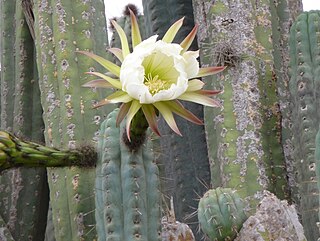
Echinopsis lageniformis, synonyms including Echinopsis scopulicola and Trichocereus bridgesii, is a cactus native to Bolivia. It is known as the Bolivian torch cactus. Among the indigenous populations of Bolivia, it is sometimes called achuma or wachuma, although these names are also applied to related species such as Trichocereus macrogonus which are also used for their psychedelic effects.

Triteleia laxa is a triplet lily known by several common names, including Ithuriel's spear, common triteleia and grassnut. It is native to California where it is a common wildflower, and it is occasionally found in southwestern Oregon. It bears a tall, naked stem topped with a spray of smaller stalks, each ending in a purple or blue flower. The flower is tubular, opening into a sharply six-pointed star. The plant grows from a corm which is edible and similar in taste and use as the potato. The most used common name for the species, Ithuriel's spear, is a reference to the angel Ithuriel from Milton's Paradise Lost.
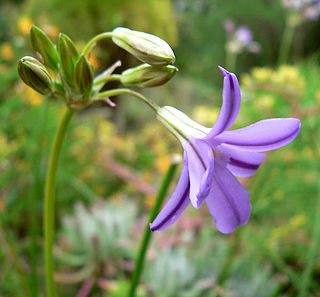
Brodiaea kinkiensis is a species of Brodiaea also with the common name San Clemente Island brodiaea. This flower is endemic to San Clemente Island, one of the Channel Islands of California.

Triteleia lugens, the Coast Range triteleia or dark-mouthed triteleia, is a monocot flowering plant in the genus Triteleia. It is endemic to California, where it is known from the Coast Ranges north and south of the San Francisco Bay Area. Its habitat includes forests and chaparral.
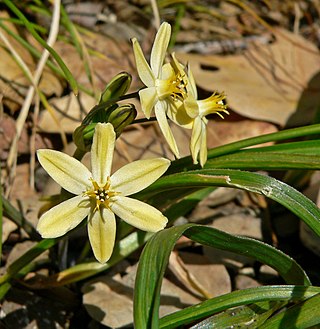
Triteleia ixioides, known as prettyface or golden star, is a monocotyledon flowering plant in the genus Triteleia. It is native to northern and central California and southwestern Oregon, where it can be found in coastal and inland coniferous forests and other habitat. It is a perennial wildflower growing from a corm. It produces one to two basal leaves up to 50 centimeters long by 1.5 wide. The inflorescence arises on an erect stem up to 80 centimeters tall. It is an umbel-like cluster of several flowers each borne on a pedicel up to 7 centimeters long. The flowers are variable in size, measuring one to nearly three centimeters in length. They are pale to bright yellow, or sometimes purple-tinged white. There are six tepals with darker midveins in shades of green, brown, or purple. The lobes are funnel-shaped and may open flat or somewhat reflexed. The six stamens form a fused tube that protrudes from the corolla; they have broad, flat filaments and whitish, yellowish, or blue anthers.
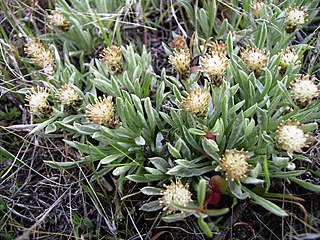
Antennaria dimorpha is a North American species of flowering plants in the family Asteraceae known by the common names low pussytoes or gray cushion pussytoes. It is native to western Canada and the western United States as far south as Riverside County in California and Rio Arriba County in New Mexico. It is generally found in dry areas. There are historical records of the species formerly occurring in northwestern Nebraska, but these populations appear now to be gone.
Brodiaea insignis is a rare species of flowering plant in the cluster-lily genus known by the common name Kaweah brodiaea. It is endemic to the Sierra Nevada foothills of central Tulare County, California, where it grows along the Tule and Kaweah Rivers. It is considered endangered on the state level.
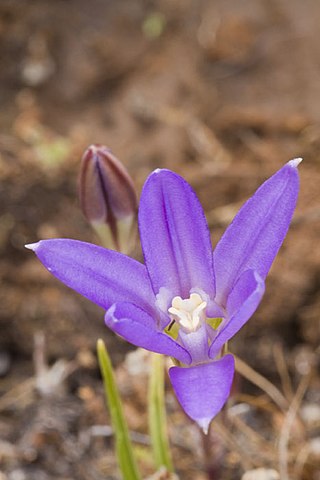
Brodiaea jolonensis, known by the common name chaparral brodiaea, is a species of flowering plant in the cluster-lily family.
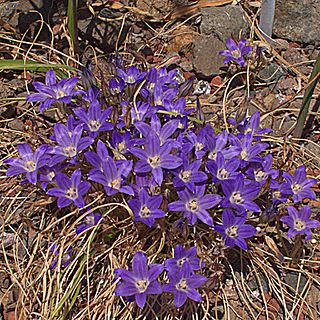
Brodiaea minor is a species of flowering plant in the cluster-lily genus known by the common names dwarf brodiaea and vernalpool brodiaea.

Brodiaea orcuttii is a species of flowering plant in the asparagus family, of the subfamily Brodiaeoideae. It is a cluster-lily known commonly as Orcutt's brodiaea. This corm-sprouting species is nearly endemic to San Diego County, with the periphery of its range reaching the southern portion of Riverside County along with some populations sparsely scattered in northwestern Baja California. Brodiaea orcuttii is usually associated with the marginal areas of vernal pools, seeps, meadows, and stream embankments, microhabitats which can generally be found from coastal mesas to interior mountains. The red-purple to blue flowers bloom from April to July. It can be distinguished from all other species of Brodiaea by its lack of staminodes.

Brodiaea pallida is a rare species of flowering plant in the cluster-lily genus known by the common name Chinese Camp brodiaea.
Brodiaea stellaris is a species of flowering plant in the cluster-lily genus known by the common name starflower brodiaea.

Triteleia clementina is a rare species of flowering plant known by the common name San Clemente Island triteleia. It is endemic to San Clemente Island, one of the Channel Islands of California, where it is known from about twenty occurrences. Its habitat includes moist, rocky, seaside grassland. It is a perennial herb growing from a corm. It produces two or three keeled, lance-shaped leaves up to 100 centimeters long by three wide. The inflorescence arises on an erect stem up to 90 centimeters tall and bears an umbel-like cluster of many flowers. Each flower is a funnel-shaped lavender or light blue bloom with six lobes measuring up to 1.5 centimeters long. There are six stamens with purple anthers.

Triteleia grandiflora is a species of flowering plant known by the common names largeflower triteleia, largeflower tripletlily, and wild hyacinth.

Triteleia hyacinthina is a species of flowering plant known by the common names white brodiaea, white tripletlily, hyacinth brodiaea, and fool's onion. It is native to western North America from British Columbia to Idaho to central California. Its habitat includes grassland and vernally moist areas such as meadows and vernal pools. It is a perennial herb growing from a corm. It produces two or three basal leaves up to 40 centimeters (16 in) long by 2 centimeters (0.79 in) wide. The inflorescence arises on an erect stem up to 60 centimeters (24 in) tall and bears an umbel-like cluster of many flowers. Each flower is a funnel-shaped bloom borne on a pedicel up to 5 centimeters (2.0 in) long. The flower is white, often tinged purple along the tubular throat, with six green-veined tepals. There are six stamens with white, yellow, or occasionally blue anthers.
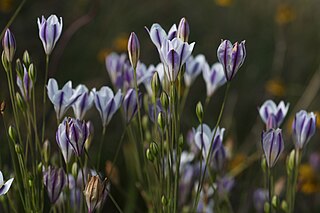
Triteleia peduncularis is a monocot flowering plant in the genus Triteleia. Its common names include long-ray brodiaea and longray triteleia. It is endemic to California, where it occurs in the coastal and inland mountain ranges of the northern and central sections of the state. It grows in vernally moist habitat such as meadows, grassland, and vernal pools, often in areas with serpentine soils. It is a perennial wildflower growing from a corm. There are two or three basal leaves measuring up to 40 cm (16 in) long and 1.5 cm (0.6 in) wide. The inflorescence arises on a smooth, erect stem up to 80 cm (31 in) tall. It is an umbel-like cluster of several flowers which are borne on very long, straight pedicels measuring up to 18 cm (7.1 in) long. Each funnel-shaped flower is white, often tinged purple, with six tepals up to 1.6 cm (0.6 in) in length. There are six stamens with white anthers, and the ovary at the center is yellow when the flower is young.


















